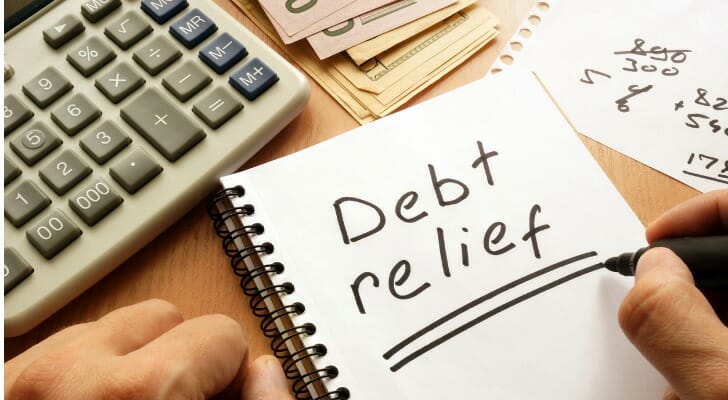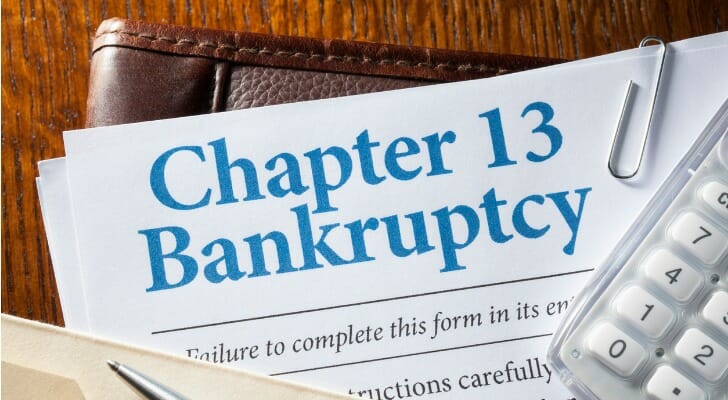Chapter 13 bankruptcy, also known as a wage earner’s plan, is a court-approved process that lets you create a repayment plan to cover most or all of your debt over the course of three to five years. Through this process, you can protect your home from foreclosure. To gain eligibility for Chapter 13 bankruptcy, your secured and unsecured debt needs to be less than certain amounts, among other requirements. To figure out if filing for Chapter 13 bankruptcy is the right move for you, a good first step is to consult with a financial professional.
How to Qualify for Chapter 13 Bankruptcy
Before you file for Chapter 13 bankruptcy, you must undergo a credit counseling program that’s approved by the U.S. Trustee’s office during the 180-day window before you file. These typically cost anywhere from $25 to $35 per course. This will help to determine if you have enough income to cover your debts through a new repayment plan.
There’s also a cap on the amount of debt you can have to qualify for Chapter 13 bankruptcy. The current limits are below, though they can be changed based on adjustments to the Consumer Price Index (CPI):
- Secured debt limit: $1,184,200
- Secured debt is backed by collateral, meaning the creditor can seize your property should you fail to make payments or default.
- Unsecured debt limit: $394,725
- Alternatively, unsecured debt is backed by collateral, such as a credit card debt or medical bills.
Preparing for Your Chapter 13 Bankruptcy Proceeding
During a Chapter 13 Bankruptcy proceeding, the court will appoint a trustee to administer the case. This trustee will collect the required documents and evaluate whether you can make timely payments through a new plan to cover all your debt. However, creditors can also object to your filing.
Here’s an overview of the steps you’ll encounter when you file for Chapter 13 bankruptcy:
- You must seek credit counseling through an approved agency.
- Be sure you prepare all of the necessary paperwork. This will include a list of creditors and what they’re owed, evidence of your income and property, a recent tax return, a description of your living expenses and more.
- You have to file a bankruptcy petition to pause debt obligations. This will run you around $300.
- Next, you’ll develop and submit a plan for your repayment.
- The court assigns a trustee who will set up a creditor meeting regarding your debt and repayment plan.
- A judge will either approve or deny your repayment plan at a confirmation hearing.
- If you gain approval and follow through with it, your bankruptcy will eventually be discharged. Of course, you’ll need to complete all of the steps above to reach this point.
As is mentioned in the second bullet above, you may need to present the a bunch of documents during a Chapter 13 bankruptcy proceeding. If you’re married, you must also present these documents for your spouse, even if you’re not filing a joint petition. The court may charge a $235 filing fee, as well as a $75 administrative fee, during the proceedings. On theme, you may be eligible to pay these expenses in installments with the court’s permission.
Here’s what you’ll need:
- Your certificate of completion for credit counseling
- Statement of financial affairs
- List of all living expenses and amounts for each
- A repayment plan, if applicable to your situation
- Report all current income and debts
- List of all creditors
- A document explaining expected increases in income
- Executory contracts and unexpired leases
- Tax returns including any filed during the proceedings
Should you receive approval, the length of your plan will depend on your income. If you make less than the applicable median state income for a family of the same size, your plan will span three years. If you make more, the plan will stretch for five years.
You would make payments to the trustee, who then sends them to your creditors. You won’t have regular contact with your creditors following approval. People usually make these payments on a monthly or bi-weekly basis. But in some cases, you may receive forgiveness for parts of your debt.
Debt Repayment Under Chapter 13 Bankruptcy

There are three types of debts you’ll pay back once your approval for Chapter 13 Bankruptcy is complete. Some take priority over others, leading to the following categories:
- Priority Debt: These are debts you must pay back in full. They include child support, alimony and most IRS tax bills.
- Secured Debt: This is debt for which a creditor has a legal right to your property if you do not pay back what you owe.
- Unsecured Debt: This type of debt involves no form of collateral. In turn, the creditor has no claim to any of your property if you don’t pay back your debt.
You may face several unforeseen circumstances and further financial hardships as you pay off your debt, even if you’re under Chapter 13 bankruptcy. But this doesn’t mean the plan dissolves if you can no longer make the same payments.
You can negotiate a new plan, for example, if you lose your job. In addition, the court may forgive some of your debts under a hardship situation. A hardship would be something like facing a debilitating illness or needing to pay for funeral expenses for a loved one.
Chapter 13 Bankruptcy: Pros and Cons
There are several benefits to filing for Chapter 13 bankruptcy instead of not filing at all. It enables you to likely hold onto your house and avoid foreclosure, as long as you’re able to gradually catch up on your debt. You’ll also earn the chance to consolidate payments and save your credit score some pain. In fact, Chapter 13 bankruptcy is expunged from your credit report after just seven years. Oftentimes, co-signers may also receive protection from liability with Chapter 13.
That said, there are still downsides to declaring Chapter 13 bankruptcy. While it won’t stay on your credit report forever, your credit score will drop significantly, making it difficult to apply for new lines of credit. You also only get one chance at creating a sticking to your repayment plan with Chapter 13. If you aren’t able to keep up, you risk losing all the assets you may have been trying to protect by filing for Chapter 13.
Comparing Chapter 13 to Other Types of Bankruptcy
There are a few different types of bankruptcies that individuals can file for. Chapter 15 is used in foreign cases, while Chapter 12 is for family farmers and Chapter 11 is for large-scale financial reorganizations. These are less common, though, as they’re reserved for much more specific situations.
Chapter 7 and Chapter 13 bankruptcy are by far the two most common types. However, the latter has significant benefits over the former because it allows you to simply restructure and create a plan for paying off debts without losing assets or property like your home. Chapter 7 bankruptcy, on the other hand, is designed for low-income and low-net-worth individuals, allowing them to liquidate their assets and cancel any unsecured debts.
The Bottom Line

Chapter 13 Bankruptcy can stay on your credit report for up to seven years. But as long as you make timely payments as agreed under your plan, your credit score would gradually improve. In any case, however, any form of bankruptcy should be a last resort.
You can negotiate some of your debt. In addition, balance transfer cards may be suitable solutions if you’re in mountain credit card debt. Consolidating your loans can also reduce your payments and help you secure more manageable interest rates. You can also seek the help of a financial advisor to guide you through wiping out your debt.
Tips for Managing Debt
- A financial advisor can be a great resource for dealing with debt and navigating bankruptcy proceedings. Finding a financial advisor doesn’t have to be hard. SmartAsset’s free tool matches you with up to three vetted financial advisors who serve your area, and you can interview your advisor matches at no cost to decide which one is right for you. If you’re ready to find an advisor who can help you achieve your financial goals, get started now.
- Any debt repayment plan begins with a good budget. Use SmartAsset’s free budget tool to figure out your ideal budget and take control of your finances today.
Photo credit: ©iStock.com/Bill Oxford, ©iStock.com/designer491, ©iStock.com/EmirMemedovski
